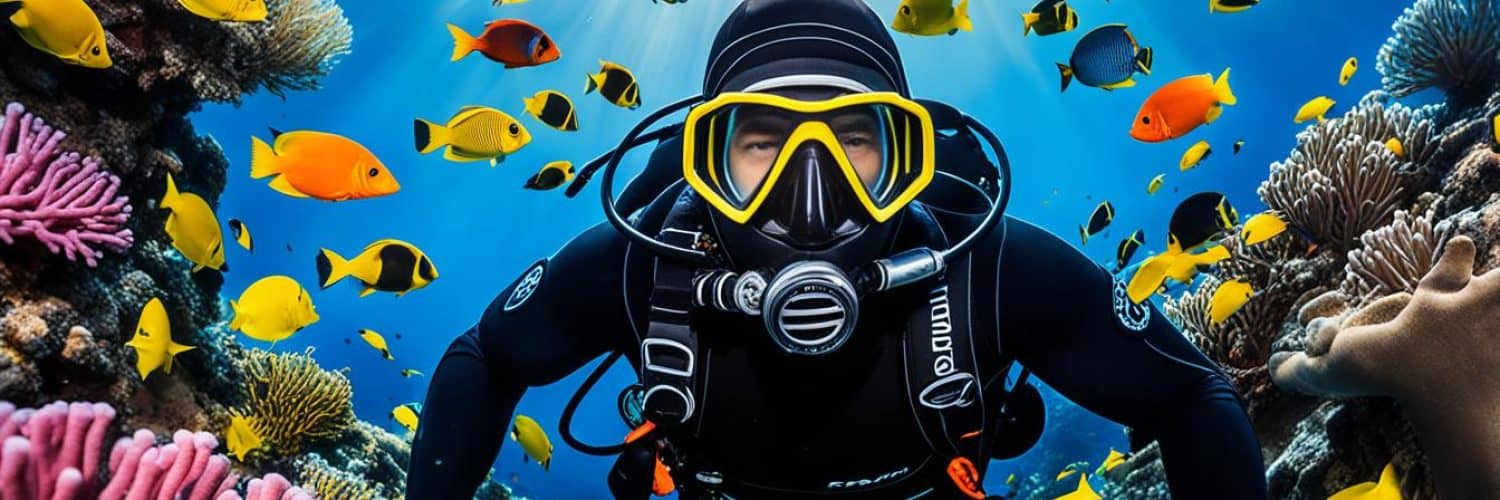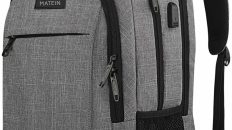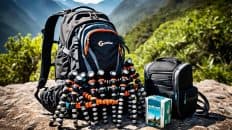A dive hood is an essential piece of equipment for scuba diving and snorkeling. It helps to maintain body temperature by insulating the head and preventing heat loss. Neoprene dive hoods are popular due to their ability to trap heat and keep the water between the hood and the head warm. There are different types of dive hoods for warm and cold water, ranging from thin neoprene hoods for warm water to thick, bib-style hoods for cold water. Choosing the right dive hood is crucial for comfort and protection in different water temperatures. Here are our top picks for the best travel dive hoods.
Key Takeaways:
- Top-rated diving hoods provide comfort and durability.
- Premium dive hoods offer high performance and protection.
- Choose a comfortable scuba hood for an improved dive experience.
- Look for a durable dive gear that can withstand wear and tear.
- The best waterproof wetsuit hood ensures maximum protection.
- Opt for top-quality dive headgear for advanced diving.
- Professional-grade dive accessories enhance your diving equipment.
Benefits of Wearing a Dive Hood
Wearing a dive hood offers numerous benefits that enhance the diving experience. One of the key advantages is heat retention, as dive hoods insulate the head, preventing the loss of body heat and keeping divers warm throughout their underwater exploration. The neoprene material commonly used in dive hoods acts as an effective barrier, trapping the heat generated by the diver’s body and minimizing heat transfer to the water. This heat retention is especially crucial in cold water environments, where the body loses heat at a faster rate than on land.
In addition to heat retention, dive hoods provide essential protection from cold water. By covering the head and ears, they reduce the risk of hypothermia and help maintain a comfortable body temperature. The insulation offered by dive hoods further contributes to comfort by preventing direct contact with cold water.
Dive hoods also play a significant role in regulating body temperature. As the head is a critical area where heat loss occurs, wearing a well-fitting dive hood ensures that the body temperature remains stable, reducing fatigue and allowing divers to enjoy longer dive sessions. The comfort offered by dive hoods eliminates distractions, enabling divers to focus on the beauty of their surroundings and fully immerse themselves in the dive experience.
Wearing a dive hood is essential for divers seeking improved comfort, protection, and regulation of body temperature. It ensures heat retention, offers insulation from cold water, and provides a comfortable and distraction-free underwater experience.
The Key Benefits of Wearing a Dive Hood:
- Heat retention, reducing fatigue and maintaining a warm body temperature
- Protection from cold water, minimizing the risk of hypothermia
- Insulation and comfort, preventing direct contact with cold water
- Regulation of body temperature, reducing fatigue and improving dive endurance
By understanding and harnessing the benefits of wearing a dive hood, divers can optimize their comfort, safety, and overall dive experience.
Factors to Consider When Choosing a Dive Hood
When selecting a dive hood, there are several important factors to take into account:
- Dive hood fit: The hood should offer a snug fit to prevent water from freely flowing in and out, ensuring maximum heat retention and insulation. A proper fit is crucial for overall comfort and performance.
- Size: Consider the size of the hood to find the best fit for your head shape and size. Different brands may have slightly different sizing charts, so refer to the manufacturer’s guidelines for accurate sizing.
- Water flow: Opt for a dive hood that minimizes water flow inside while underwater. This helps maintain warmth and prevents unpleasant sensations caused by excessive water movement.
- Ear equalization: Ensure the hood allows for proper ear equalization during descents and ascents. Too much pressure or a tight fit can interfere with equalizing your ears, potentially causing discomfort or injury.
- Hood thickness: Consider the desired water temperature when selecting the hood’s thickness. Thicker neoprene hoods provide better insulation in colder water, while thinner hoods are suitable for warmer conditions.
- Neoprene: Neoprene is a popular material for dive hoods due to its excellent insulating properties. Look for high-quality neoprene hoods that offer durability and flexibility for a comfortable fit.
- Warm water vs cold water hoods: Determine the type of diving you’ll be doing most frequently. Warm-water hoods are typically thinner and cover less of the face, while cold-water hoods are thicker with extended coverage and may feature a bib for added warmth.
- Bib: Cold-water hoods often come with a bib that can be tucked into the wetsuit. This provides an additional layer of insulation, ensuring you stay warm in chilly water temperatures.
- Face coverage: Consider the amount of face coverage you prefer. Cold-water hoods generally offer more coverage, including protection for the forehead, cheeks, and chin, while warm-water hoods typically cover the head and ears.
By considering these factors, you can choose a dive hood that provides a comfortable and secure fit while keeping you warm and protected underwater.
Comparison of Different Dive Hood Factors
| Factor | Warm Water Hoods | Cold Water Hoods |
|---|---|---|
| Hood Fit | Snug fit to prevent water flow | Snug fit to prevent water flow |
| Size | Varies by brand; follow manufacturer’s size chart | Varies by brand; follow manufacturer’s size chart |
| Water Flow | Minimizes water flow inside the hood | Minimizes water flow inside the hood |
| Ear Equalization | Allows for proper ear equalization | Allows for proper ear equalization |
| Hood Thickness | Thin neoprene for warmer conditions | Thicker neoprene for colder conditions |
| Neoprene | High-quality neoprene for insulation | High-quality neoprene for insulation |
| Warmth | Less coverage and insulation | More coverage and insulation |
| Bib | No bib | Includes a bib for added warmth |
| Face Coverage | Head and ears coverage | Extended coverage for forehead, cheeks, and chin |
“Choosing the perfect dive hood involves considering factors such as fit, size, water flow, ear equalization, thickness, neoprene quality, warmth requirements, bib inclusion, and face coverage. By understanding these factors, divers can make an informed decision that ensures comfort and protection during their underwater adventures.”
Best Dive Hood for Warm Water
The Probe Insulator Hood is our top pick for warm water diving. Made of 0.5mm neoprene, this hood provides added protection and comfort during your underwater adventures. Its lightweight design makes it ideal for travel, ensuring convenience and ease of packing.
While primarily designed for warm water use, the Probe Insulator Hood also serves as an excellent layer of protection when worn under a conventional thicker hood in temperate and cold waters. By adding an extra layer of insulation, it enhances comfort and safeguards against heat loss, making it a popular choice for divers seeking versatility and adaptability in their dive gear.
With its exceptional combination of performance, comfort, and convenience, the Probe Insulator Hood has earned its reputation as a reliable and popular choice among divers exploring warm water environments.
Best 3mm Dive Hood for Temperate Water
When it comes to diving in temperate waters, having the right gear is essential for comfort and performance. That’s why we recommend the Probe iDry Quick-Dry Hood in 3mm thickness as the best dive hood for these conditions.
This hood is designed to provide optimal protection and convenience during your dives. Its 3mm thickness strikes the perfect balance between insulation and flexibility, keeping you warm without compromising your mobility.
One of the standout features of the Probe iDry Quick-Dry Hood is its fast-drying capability. The Quick-Dry fleece inner lining helps to wick away moisture, allowing the hood to dry quickly between dives. This ensures that you stay comfortable and dry, avoiding the discomfort of a wet hood.
Another key feature of this dive hood is the gripper print on the back of the head. This innovative design keeps your mask strap securely in place, preventing any slippage during your dive. It’s a small detail that makes a big difference in your overall experience.
Donning and doffing the Probe iDry Quick-Dry Hood is a breeze, thanks to its thoughtful design. The hood is easy to put on and take off, saving you time and effort on the boat or at the dive site. You can focus on enjoying your dive rather than struggling with your gear.
Overall, the Probe iDry Quick-Dry Hood in 3mm thickness is the perfect choice for divers exploring temperate waters. Its combination of fast-drying technology, gripper print, and easy donning and doffing make it a top-notch dive hood that delivers both comfort and functionality.
Best 5mm Dive Hood for Temperate Water
The Probe iDry Quick-Dry Hood is the perfect choice for divers exploring temperate water conditions. With its 5mm thickness, this dive hood provides enhanced insulation and warmth, ensuring a comfortable diving experience even in cooler temperatures.
When comparing the 5mm and 3mm versions, it’s important to consider individual cold sensitivity and the water temperature. The 5mm hood is ideal for divers who are more sensitive to cold temperatures and require additional protection to keep critical heat loss areas insulated.
Dive hoods play a crucial role in regulating body temperature while underwater, and the Probe iDry Quick-Dry Hood excels in providing optimal warmth and comfort. Its design covers critical heat loss areas, ensuring that divers can fully enjoy their time in temperate water.
Key Features:
- 5mm thickness for increased insulation
- Provides additional protection for divers sensitive to cold temperatures
- Covers critical heat loss areas for enhanced warmth and comfort
Experience the ultimate dive with the best 5mm dive hood for temperate water – the Probe iDry Quick-Dry Hood.
Best 5/7mm Dive Hood for Cold Water
When it comes to cold water diving, the Waterproof H1 Venting Hood with Bib is the best choice for divers seeking optimal protection and insulation. With its 5/7mm thickness, this hood is designed to withstand icy conditions and keep divers warm even in the harshest environments. The double layered protection in critical heat loss areas ensures that body heat is effectively retained, allowing divers to stay comfortable throughout their dives.
One of the key features of the Waterproof H1 Venting Hood with Bib is its glideskin seals for the neck and face. These seals create a watertight barrier, preventing cold water from seeping in and reducing heat loss. The bib design offers additional water transfer reduction, keeping divers warm and cozy during extreme cold or ice water diving adventures.
Here are the key features of the Waterproof H1 Venting Hood with Bib:
- 5/7mm thickness for excellent insulation
- Double layered protection in critical heat loss areas
- Glideskin seals for the neck and face
- Bib design for reduced water transfer
Stay warm and protected with the Waterproof H1 Venting Hood with Bib, the ultimate solution for cold water diving.
| Product | Thickness | Heat Loss Protection | Seals | Water Transfer Reduction |
|---|---|---|---|---|
| Waterproof H1 Venting Hood with Bib | 5/7mm | Double layered | Glideskin | Bib design |
Best Ice Cold Water Dive Hood Accessory
In extremely cold diving conditions, having the right gear is crucial for ensuring maximum protection and comfort. One standout accessory that provides additional insulation is the Waterproof H1 Icehood. Designed specifically for severe cold diving conditions, this accessory offers unparalleled warmth and protection in ice-cold water.
The Waterproof H1 Icehood features a stretchy over-hood design that covers all exposed skin, providing an extra layer of insulation. With a thickness of 2mm, this hood effectively retains heat and keeps divers comfortable even in freezing temperatures.
This icehood is carefully crafted to offer a snug fit, ensuring minimal water flow and maximum warmth. Its stretchy construction allows for easy donning and ensures a secure and comfortable fit throughout the dive.
For divers venturing into severe cold diving conditions, the Waterproof H1 Icehood is a must-have accessory. Its specialized design and 2mm thickness provide the additional protection needed to combat the extreme cold and maintain body temperature in adverse conditions.
Dive Hood Maintenance and Accessories
Proper maintenance of your dive hood is essential to ensure its longevity and optimal performance. By following a few simple steps, you can keep your dive hood clean, fresh, and ready for your next underwater adventure.
Rinsing: After each dive, rinse your dive hood thoroughly with fresh water. This will help remove any saltwater, sand, or debris that may have accumulated during your dive. Be sure to rinse both the inside and outside of the hood to ensure a complete clean.
Wetsuit Wash: To remove dirt and eliminate any unpleasant odors, consider using a wetsuit wash or shampoo specifically designed for dive gear. These products are formulated to effectively clean neoprene materials, leaving your dive hood smelling fresh and ready for your next dive.
Drying: Properly drying your dive hood is crucial to prevent mold and prolong its lifespan. Hang your hood in a well-ventilated area out of direct sunlight. Allow it to air dry completely before folding or storing it away. Avoid using heat sources like hairdryers or radiators, as they can damage the neoprene material.
Storage: When storing your dive hood, make sure it is completely dry to prevent the growth of mold or mildew. Store it in a cool, dry place away from direct sunlight. Folding the hood gently and placing it in a mesh or cloth bag can help protect it from dust and other potential damage.
Aside from proper maintenance, there are also dive hood accessories that can enhance your dive gear organization and maintenance routine.
Underwater Kinetics Super Accessory Hanger
This super accessory hanger is designed to keep your dive gear organized and easily accessible. It features specially designed hooks to hang your dive hood, boots, gloves, and fins. With its sturdy construction, it can support the weight of your gear while keeping everything tidy and in one place.
Adrenalin Wetsuit and Gear Wash Concentrate
For a thorough cleaning of your neoprene dive hood, the Adrenalin Wetsuit and Gear Wash Concentrate is an excellent choice. This concentrated formula effectively removes dirt, salt, and odors from your dive hood, leaving it fresh and ready for your next dive. Simply follow the instructions on the bottle for best results.
By following these maintenance tips and utilizing the right accessories, you can ensure that your dive hood remains in excellent condition, providing you with comfort, protection, and optimal performance every time you take the plunge.
Choosing the Right Dive Mask
Choosing the right dive mask is essential for a comfortable and enjoyable dive experience. Several factors should be considered to ensure you select a mask that suits your needs and preferences.
Durable Materials
Opt for dive masks made from durable materials that can withstand the harsh underwater environment. Look for masks with tempered glass windows, which provide excellent clarity and are less prone to breaking compared to regular glass.
Silicone Skirt
A soft silicone skirt creates a watertight seal on your face, preventing leaks and offering enhanced comfort. Select a mask with a high-quality silicone skirt that fits snugly without causing discomfort.
Adjustment Straps
Ensure the mask has user-friendly adjustment straps that allow you to achieve a secure and customizable fit. Easy-to-adjust straps enable quick and hassle-free adjustments, even when wearing gloves.
Volume
The volume of a mask affects how easily it clears. Low-volume masks require less effort to clear water from, making them a popular choice for freediving and spearfishing. High-volume masks are preferred by some divers who prioritize a larger field of vision.
Window Design
Decide between a mask with one window or two. Masks with one large window provide a wider field of vision and are often preferred by recreational divers. Masks with two windows may offer better visibility in certain conditions.
Framed vs. Frameless Masks
Framed masks have a rigid structure that provides stability and helps maintain the shape of the mask. Frameless masks are more compact, making them easier to pack and travel with. Consider your preferences and diving style when choosing between framed and frameless masks.
Black vs. Clear Silicone
Choose between masks with black or clear silicone skirts. Black silicone reduces glare and distractions, making it ideal for underwater photography. Clear silicone provides a brighter and more open feel, preferred by some divers.
Masks for Narrow Faces and Kids
If you have a narrow face or are purchasing a mask for a child, look for masks specifically designed to accommodate these sizes. A proper fit ensures a comfortable seal and prevents leaks.
Fog-Free Masks
Some masks come with anti-fog coatings or systems to minimize fogging during dives. These masks are particularly useful in humid environments or for divers who tend to experience fogging more frequently. Keep in mind that regular maintenance is still necessary for optimal performance.
Prescription Scuba Masks
For divers who require prescription lenses, prescription scuba masks are available. These masks can be custom-made to match your specific prescription, providing clear vision underwater.
Full-Face Masks
Full-face masks cover the entire face, offering enhanced comfort and allowing for natural breathing through both the nose and mouth. Some full-face masks also come with communication capabilities, enabling divers to communicate underwater with ease.
Choosing the right dive mask requires considering factors such as materials, fit, design, and additional features. Take your time to find a mask that suits your preferences and ensures a comfortable and clear underwater experience.
Conclusion
Choosing the best travel dive hood is crucial for ensuring comfort, durability, and optimal performance underwater. When selecting a dive hood, it is important to consider factors such as fit, thickness, and water temperature. A well-fitting hood that provides sufficient insulation will keep you comfortable and protected during your dives.
In addition to choosing the right dive hood, proper maintenance of your dive gear is essential for its longevity. Remember to rinse your hood with fresh water after each dive, both inside and outside, and allow it to dry completely before storing it. By taking these steps, you can ensure that your dive hood remains in top condition for many future adventures.
When it comes to selecting a dive mask, consider factors such as the materials used, adjustment straps, volume, and window design. Finding a mask that fits well and offers clear vision underwater is key. Don’t forget to take your personal preferences into account, such as silicone color and mask size, to ensure a comfortable and enjoyable diving experience.
By carefully considering dive hood selection, conducting regular gear maintenance, and choosing the right dive mask, you can enhance your diving experience and fully immerse yourself in the wonders of the underwater world. So dive in, explore, and enjoy every moment of your underwater adventures with confidence.
FAQ
What are the benefits of wearing a dive hood?
Wearing a dive hood helps to retain body heat, regulate body temperature, protect from cold water, provide insulation and comfort, and improve the overall dive experience.
What factors should I consider when choosing a dive hood?
Factors to consider when choosing a dive hood include fit, size, water flow, ear equalization, hood thickness, neoprene material, warm water vs. cold water suitability, and face coverage.
What is the best dive hood for warm water?
The Probe Insulator Hood, with its 0.5mm thickness, is our top pick for warm water diving. It offers added protection and comfort, and can also be worn as an extra layer of protection under a thicker hood in temperate and cold waters.
What is the best 3mm dive hood for temperate water?
The Probe iDry Quick-Dry Hood, with its 3mm thickness, is our top choice for temperate water diving. It is known for its fast drying capabilities, grip print to keep the mask strap in place, and easy donning and doffing.
What is the best 5mm dive hood for temperate water?
The Probe iDry Quick-Dry Hood, with its 5mm thickness, is our recommended choice for divers who are more sensitive to cold temperatures in temperate water. This hood provides extra insulation and covers critical heat loss areas for added warmth and comfort.
What is the best 5/7mm dive hood for cold water?
The Waterproof H1 Venting Hood with Bib, with its 5/7mm thickness, is our top pick for cold water diving. It offers excellent insulation in icy conditions, with double layered protection in critical heat loss areas and glideskin seals for the neck and face.
What is the best accessory for ice cold water diving?
The Waterproof H1 Icehood, a 2mm stretchy over-hood, is the best accessory for diving in extremely cold conditions. It covers all exposed skin and can be worn over a regular neoprene hood for maximum warmth in severe cold diving conditions.
How should I maintain my dive hood?
Proper maintenance includes rinsing the hood with fresh water, both inside and outside, using wetsuit wash or shampoo to remove dirt and salt residue, drying the hood completely before storing it in a dry, shaded area, and using accessories like the Underwater Kinetics Super Accessory Hanger for organization.
How do I choose the right dive mask?
When choosing a dive mask, consider factors such as durable materials, tempered glass windows, a soft silicone skirt, user-friendly adjustment straps, a sturdy main mask strap, volume for easy clearing, window design for a wider field of vision, and personal preferences like silicone color, size, and special features like communication capabilities or prescription lenses.
What is a good dive mask maintenance routine?
How can I enhance my dive experience with the right dive hood and mask?
By selecting the right dive hood and mask, divers can ensure comfort, durability, and top-tier underwater performance. The right gear will provide proper insulation, protection, and clear vision, enhancing the overall dive experience.







Add comment